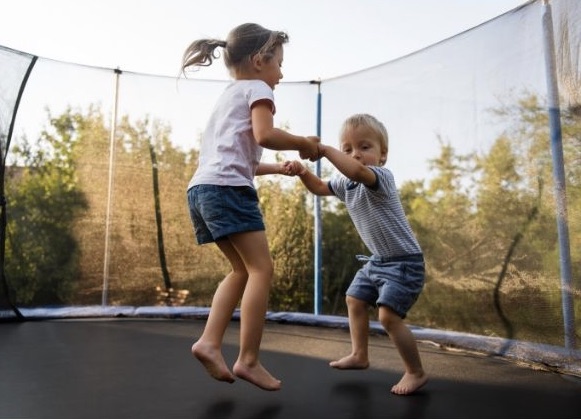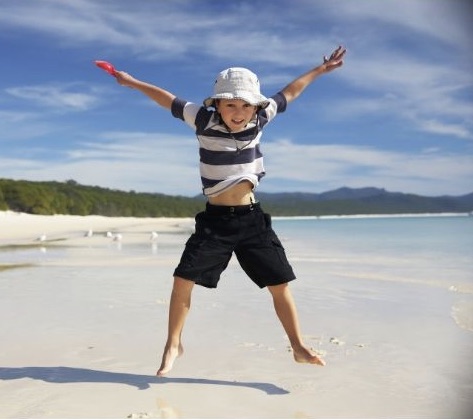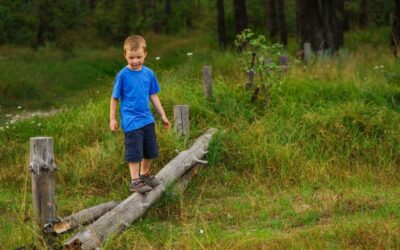Why is jumping important?
The 2018 Active Healthy Kids Australia Report Card recently highlighted declines in the jumping ability of Australian children and young people which indicate that ‘it’s time for a jump start’ for muscular fitness.
When we think about the Health Guidelines for young children, we know that they should be physically active for 3 hours every day – of which one hour should be vigorous activity which gets the child huffing and puffing.
What comes to mind is aerobic activity such as running, climbing, cycling – but what is often forgotten is that young children also need to engage in bone and muscle strengthening activities in order to maintain health.
Strength conditioning conjures up images of expensive equipment, personal trainers and gyms – but none of this is necessary for young children to build up and maintain their bone density and muscle strength. Their own body weight is all that is needed.
Once toddlers are running, climbing on furniture and managing stairs they are ready to practice jumping – at first their feet may only just clear the ground, but with practice and maturity they will graduate to jumping off a small beam or step, to jumping over a low obstacle to eventually jumping for distance (long or broad jump) or height (vertical leap). These skills continue to mature and be refined throughout the lifespan with practice.
Jumping is FUN!
Jumping is somehow closely linked to our emotions of joy and excitement. We sometimes involuntarily jump for joy and throw our arms up in the air when our team wins or kicks a goal. Do you remember the delight of jumping up and down on your parent’s bed? Let’s tap into that fun factor and increase the opportunities we provide for young children to jump.
Benefits of Jumping
- Improves balance and coordination
- Is a whole body exercise
- Improves cardio-vascular health
- Improves bone density
- Improves muscle strength
Let’s Jump!
Wet weather can bring some challenges for vigorous outdoor play – but with the right clothing – it can also present some wonderful opportunities. Pull on the wet weather gear and gum boots and see how many puddles you can find to jump in, over and through.
Trampoline jumping (rebounding) is an enjoyable exercise for children and adults and something that you can often do together. Modern trampolines have good safety measures with covered springs and zippered enclosures – but supervision and care should always be taken to ensure the equipment is used appropriately.
But as with any form of exercise – it should not be done for extended periods of time and should be balanced with other forms of physical activity in order to avoid any stress related injuries.

At the beach or in a sandpit – mound up a big pile of sand (digging is good for shoulder and arm strength) and then delight in jumping on the mound to squash it back down.

Jumping Technique
Jumping is a whole body exercise which is comprised of the preparation phase (bending of the knees, hips, arms swing backwards), the take off phase (arms are propelled forwards and upwards as the body pushes off from the ground) and the landing phase (the arms come down to extend in front of the body and the feet land together with knees and hips bent). This requires motor planning and sequencing skills.
Jumping Games for Kids
Elastics
During a recent visit to a school in Perth, I was absolutely delighted to hear that “Elastics” had made a come back and that this playground game was equally enjoyed by boys and girls. Whilst the more complex sequences are suitable for older children – young children can also enjoy the games by following a simple sequence and restricting the height of the elastic to ankles.If you are not familiar with this game – here is brief synopsis:

Equipment: I x large loop of elastic (you don’t need to buy a commercial product, just grab a large length – about 4-5 metres of 1-2 cm wide elastic and sew or tie it together to make a loop).
Generally played with at least three people – two people are the ends and place the elastic around their ankles with their feet spread about shoulder width apart. The third player is the jumper.
Rules and sequence of jumping varies and can be made up- but generally the jumper has to jump and land with feet either side of the elastic, with both feet in the middle, or both feet outside the elastic – stepping on the elastic or missing a sequence means you are out and the jumper swaps places with one of the children holding an end.
See this YouTube Clip for an example
Elastics is also a social game and gives children who may not be confident in their motor abilities a chance to join in the play by perhaps volunteering to be an “end” person to begin with. Because there are gradual stages of difficulty ie ankles, calves, knees, thighs, waists, arm pits, necks – and normal stance, wides and skinnies – children can remain in the whatever stage they can manage for as long as necessary. The increased practice will lead to increased competence and improvement in not only their jumping ability but also their sequencing skills and social skills.
Elastics can also be practiced alone by using two chairs to hold the ends of the elastic.
Jumping Jacks (Star Jumps)
Old Fashioned Jumping Jacks – Great for cardio-vascular fitness as well as strengthening muscles and bones. This activity also requires motor planning, sequencing and coordination skills. No expensive equipment and can be done anywhere – just ensure there is sufficient space for the children to extend their arms without bumping into anyone. Perfect for a mini break in between lessons.

Animal Fun Jumps
Animal Fun’s Kangaroo Jumps and Frog Jumps encourages children to use their imagination whilst performing the jumps. Use jumping activities when teaching number, shape, colour recognition – by matching a motor skill to a cognitive task helps children to embed the learning while they are also building muscle and bone strength. Check out our programs and resources here.
Jumping Rope (Skipping)
Can be done alone or with a group of friends using a long rope with one person at each end in charge of turning the rope. This is a social activity and promotes turn taking but it is also great for your brain and overall mental health as described in this article from Brain HQ. A great place to start for young children is to have a long rope with adults (or older children) holding each end and gently swing the rope back and forth, keeping it close to the ground and encourage the child to jump with both feet over the rope. Jumping is great for building bone density and can be less damaging than running as the landing force is dispersed by two feet/legs instead of one.

Improve with Practice
Improving on your own personal best is a great way to help children to aim for improvement without it being overly competitive. Whilst there are commercial broad jump and vertical leap assessment equipment available – you could simply mark out an area on a smooth path with masking tape set at 5cm apart with a Start line.
Children take turns standing on the start line – then do a broad jump (long jump) as far as they can. The adult then records the distance achieved for each child. Practising this jump every day (perhaps the best of three attempts) will allow the child to see their improvement over time with practice.
Similarly, the vertical leap can be practised by marking out the height in 2 or 5 cm intervals on a veranda post or basketball ring with a marker. The child stands next to the post and reaches up as they jump for height. The adult notes the mark touched and records the height.
Doing More is Not Necessarily Better
Research suggests that at a cellular level bones seem to have a sensitivity or “listening force” level – for example, once a child has done say 10 jumps, they have maxed out their bone creation capacity for the following few hours. So be doing 1 session of 20 minutes of constant jumping once a week is significantly less effective than a small number of jumps spread throughout the day.
Variety of physical activity is always the key in order to avoid strain or over-use injury.







Hi Sue,
I work with pre schoolers, can you perhaps suggest some jumping activities that would be geared towards their abilities
Cheers
Jacqui
Hi Jacqui, I would suggest you encourage the little ones to jump around with no purpose as a starting point – think crazy dance moves…then perhaps progress to jumping off a very low balance beam onto a mat, or off the edging of the sandpit into the sand – then maybe graduate to piling up the sand as mentioned above. You might also use pavement chalk to draw a small creek, with stepping stone “rocks” as a crossing – encourage the children to jump on each rock to cross the creek. Using hopscotch markings, young pre-schoolers can jump onto each square rather than hopping. Even marking out a series of lines on a path at say 30 com distance apart – children can then alternate – jumping on each line, or jumping in the spaces. Laying out 10 hoops in 2 rows (5 side by side) – encourage children to jump sideways in a zig zag pattern. Very young children tend to try to jump using their body, with their feet barely lifting off the ground) – the key is to demonstrate the bend and swing of the arms. Look for balance and control. Children who have poor balance and weak core strength may find it difficult to jump – so maybe take a step back and look at developing balance skills first. I hope that answers your question – if not feel free to give me a call.
Very much like your information
Thanks Kerry!
Hello,
I have a 7 yo son who has been diagnosed with anxiety. He is very active but does not play any contact or team sport. Can you please recommend something safe for him to try which will boost his confidence but also keep his anxiety low.
Thank you.
Hello Neha,
it is very difficult to comment without knowing your son but I am hoping that the medical expert who diagnosed his anxiety would be able to give you some suggestions which would be suitable. However, as a very general comment, I would suggest trying to find some activity which sparks his interest. Because if we are interested in something then we are more likely to persevere and practice and that continued practice leads to improvement and this can boost our self confidence and self esteem. Joining a team or a club has the added benefits of social interactions with a wider circle of people. Sports which are more solitary in nature might be more appealing to your son – eg golf, martial arts, archery, paddling/canoeing – something that allows him to proceed at his own pace without the need to keep up with others. Small improvements may be all tht is needed to boost confidence and reduce anxiety. I hope this response provides you with a few ideas – but always best to check with your medical professional before making final decisions.
Hello Sue
I’m a student occupational therapist and at the moment I’m working with 4 and 5 years old childeren at my internship. During PE I have observed that some childeren attempt to jump using mostly their bodies, barely lifting their feet off the ground. Additionally, I’ve also notice that some have difficulty landing balanced on both feet when jumping off an object. Could you provide tips on how to differentiate the lesson so that each child can have a successful experience with jumping both up and off something? Or how I can improve these skills?
Hi Julie, I will respond in more detail to you directly via email, but briefly, in order to have success at jumping activities, children firstly need to have some strength in their legs. With increased sedentary behaviours, this strength is lacking in many children. Modules 1-4 of the Animal Fun program focus on building strength in the core and the lower limbs and many of these will be helpful as you prepare children for jumping activities. Maybe you can demonstrate for the children that jumping involves a squat then a spring up, using the arms to gain height, and again when landing- bend the knees to a squat to absorb the impact using the arms as counter balances. You might also encourage jumping for height by hanging an object such as a balloon above the children to give them something to aim for as they reach up.